前言
本周写文的核心为 Promise ,Promise 大家应该都特别熟悉了,Promise 是异步编程的一种解决方案,广泛用在日常编程中。本周小包将围绕 Promise 源码手写进行写文,源码手写初步计划使用三篇文章实现—— 手写 Promise 之基础篇,手写 Promise 之 resolvePromise 篇,手写 Promise 之静态方法篇。
Promises/A+ 规范是 Promise 的实现准则,因此 Promise 手写系列将遵循 Promises/A+ 规范的思路,以案例和提问方式层层深入,一步一步实现 Promise 封装。
学习本文,你能收获:
基础铺垫
Promise 必定处于下列三种状态之一:
Pending 等待态: 初始状态,不是成功或失败状态。
Fulfilled 完成态: 意味着操作成功完成。
Rejected 失败态: 意味着操作成功失败。
当 promise 处于 Pending 状态时,可以转变为 Fulfilled 或者 Rejected
当 promise 处于 Fulfilled 或 Rejected 时,状态不能再发生改变
那什么会触发 promise 中状态的改变呐?我们来看几个栗子:
// p1 什么都不执行且传入空函数const p1 = new Promise(() => {});console.log("p1: ", p1);
// p2 执行 resolveconst p2 = new Promise((resolve, reject) => { resolve("success");});console.log("p2: ", p2);
// p3 执行 rejectconst p3 = new Promise((resolve, reject) => { reject("fail");});console.log("p3: ", p3);
// p4 抛出错误const p4 = new Promise((resolve, reject) => { throw Error("error");});console.log("p4: ", p4);
// p5 先执行 resolve 后执行 rejectconst p5 = new Promise((resolve, reject) => { resolve("success"); reject("fail");});console.log("p5: ", p5);
// p6 什么都不执行且不传参const p6 = new Promise();console.log("p6: ", p6);
复制代码
我们来看一下输出结果:
从输出结果我们可以发现:
创建 promise 对象时,需传入一个函数(否则会报错,详见 p6),并且该函数会立即执行
promise 的初始状态为 Pending(见 p1)
执行 resolve() 和 reject() 可以将 promise 的状态修改为 Fulfilled 和 Rejected (见 p2,p3)
若 promise 中抛出异常,相当于执行 reject (见 p4)
promise 状态转变只能由 Pending 开始(见 p5)
根据我们对输出结果的分析,我们来编写 promise 的第一版代码。
实现基础 promise —— 第一版
promise 构造函数实现
首先定义 promise 的三种状态
const PENDING = "PENDING";const FULFILLED = "FULFILLED";const REJECTED = "REJECTED";
复制代码
定义 Promise 构造函数,添加必备属性
Promises/A+ 规范中指出:
我们使用 ES6 class 定义 Promise 类,value/reason 分别赋值为 undefined ,状态 status 初始为 PENDING
class Promise { constructor() { this.value = undefined; this.reason = undefined; this.status = PENDING; }}
复制代码
定义 promise 时需要传入函数 executor
class Promise { constructor(executor) { this.value = undefined; this.reason = undefined; this.status = PENDING; // 定义resolve 和 reject 函数 const resolve = () => {}; const reject = () => {}; // 构造器立即执行 executor(resolve, reject); }}
复制代码
实现 resolve 和 reject 的功能
当 promise 状态为 Pedding 时: resolve 函数可以将 promise 由 Pending 转变为 Fulfilled,并且更新 promise 的 value 值。reject 函数可以将 promise 由 Pending 转变为 Rejected,并且更新 promise 的 reason 值
注意: promise 状态只能由 Pending -> Fulfilled 和 Pending -> Rejected
因此在定义 resolve 和 reject 函数时,内部需要先判断 promise 的状态,如果状态为 pending ,才可以更新 value 值和 promise 状态。
class Promise { constructor(executor) { this.value = undefined; this.reason = undefined; this.status = PENDING;
const resolve = (value) => { // 判断当前的状态是否为Pending // promise状态转变只能从 Pending 开始 if (this.status === PENDING) { // 更新 value 值和 promise 状态 this.value = value; this.status = FULFILLED; } }; const reject = (reason) => { if (this.status === PENDING) { this.reason = reason; this.status = REJECTED; } };
executor(resolve, reject); }}
复制代码
源码写到这里,小包就产生疑惑了本文第一个疑问,来,上问题。
提问一: resolve/reject 函数为什么使用箭头函数定义?
问题答案小包这里先不讲,大家先思考思考,到文末小包一块回答。
Promise A+ 规范规定,Promise 执行抛出异常时,执行失败函数。因此我们需要捕获 executor 的执行,如果存在异常,执行 reject 函数。
class Promise { // ...多余代码先暂省略 // 捕获 executor 异常 try { executor(resolve, reject); } catch (e) { // 当发生异常时,调用 reject 函数 reject(e); } }}
复制代码
我们实现完了 Promise 的主体部分,下面就来实现 Promise 的另一重要核心 then 方法。
实现 then 方法的基本功能
then 方法的注意事项比较多,咱们一起来阅读规范顺带举例说明一下。
promise.then 接受两个参数:
promise.then(onFulfilled, onRejected);
复制代码
定义 then 函数,接收两个参数
class Promise { then (onFulfilled, onRejected) {}}
复制代码
onFulfilled 和 onRejected 是可选参数,两者如果不是函数,则会忽略掉(真的是简单的忽略掉吗?请看下文值穿透)
如果 onFulfilled 是一个函数,当 promise 状态为 Fulfilled 时,调用 onFulfilled 函数,onRejected 类似,当 promise 状态为 Rejeted 时调用。
我们继续来看几个栗子:
// 执行 resolveconst p1 = new Promise((resolve, reject) => { resolve(1);});p1.then( (v) => { console.log("onFulfilled: ", v); }, (r) => { console.log("onRejected: ", r); });
// 执行 rejectconst p2 = new Promise((resolve, reject) => { reject(2);});p2.then( (v) => { console.log("onFulfilled: ", v); }, (r) => { console.log("onRejected: ", r); });
// 抛出异常const p3 = new Promise((resolve, reject) => { throw new Error("promise执行出现错误");});p3.then( (v) => { console.log("onFulfilled: ", v); }, (r) => { console.log("onRejected: ", r); });
复制代码
我们来看一下输出结果:
通过输出结果,我们可以发现 then 的调用逻辑
接下来,我们来分析一下 then 的实现思路。
then 函数中判断 promise 当前的状态,如果为 Fulfilled 状态,执行 onFulfilled 函数;Rejected 状态,执行 onRejected 函数。实现思路很简单,那下面咱们就来实现一下。
class Promise { then(onFulfilled, onRejected) { // 当状态为 Fulfilled 时,调用 onFulfilled函数 if (this.status === FULFILLED) { onFulfilled(this.value); } // 当状态为 Rejected 时,调用 onRejected 函数 if (this.status === REJECTED) { onRejected(this.reason); } }}
复制代码
提问二: then 方法执行时 promise 状态会出现 Pending 状态吗
promise 注册多个 then 方法
我们继续往下读规范:
如果一个 promise 调用多次 then: 当 promise 状态为 Fulfilled 时,所有的 onFulfilled 函数按照注册顺序调用。当 promise 状态为 Rejected 时,所有的 onRejected 函数按照注册顺序调用。
这个规范讲的是什么意思那?小包来举个栗子:
const p = new Promise((resolve, reject) => { resolve("success");});
p.then((v) => { console.log(v);});p.then((v) => { console.log(`${v}--111`);});
复制代码
输出结果:
通过上面的案例,该规范通俗来讲: 同一个 promise 可以注册多个 then 方法,当 promise 完成或者失败后,对应的 then 方法按照注册顺序依次执行。
该规范咱们的代码已经可以兼容。学到这里,我们整合一下 Promise 第一版代码,并对目前所写代码进行测试。
// promise 三种状态// 状态只能由 PENDING -> FULFILLED/REJECTEDconst PENDING = "PENDING";const FULFILLED = "FULFILLED";const REJECTED = "REJECTED";
class Promise { constructor(executor) { this.value = undefined; this.reason = undefined; // 初始状态为 Pending this.status = PENDING; // this指向问题 const resolve = (value) => { // 判断当前的状态是否为Pending // promise状态转变只能从 Pending 开始 if (this.status === PENDING) { // 更新 value 值和 promise 状态 this.value = value; this.status = FULFILLED; } }; const reject = (reason) => { if (this.status === PENDING) { this.reason = reason; this.status = REJECTED; } }; try { // 捕获 executor 异常 executor(resolve, reject); } catch (e) { // 当发生异常时,调用 reject 函数 reject(e); } } then(onFulfilled, onRejected) { // 当状态为 Fulfilled 时,调用 onFulfilled函数 if (this.status === FULFILLED) { onFulfilled(this.value); } // 当状态为 Rejected 时,调用 onRejected 函数 if (this.status === REJECTED) { onRejected(this.reason); } }}
复制代码
先来测试基础部分的案例,输出结果如下:
再来测试同一 Promise 注册多个 then 方法,输出结果为
第一版代码是可以满足当前规范的,~~~,放松一下,我们来继续实现。
处理异步功能——第二版
文章刚开始我们就讲过,promise 是异步编程的一种解决方案,那我们来测试一下第一版 Promise 是否可以实现异步。
const p = new Promise((resolve, reject) => { // 使用 setTimeout 模拟一下异步 setTimeout(() => { resolve("success"); });});
p.then((v) => { console.log(v);});p.then((v) => { console.log(`${v}--111`);});
复制代码
没有任何输出,可见第一版代码到目前是无法实现异步编程的,我们来分析一下原因。
如果 Promise 内部存在异步调用,当执行到 then 函数时,此时由于 resolve/reject 处于异步回调之中,被阻塞未能调用,因此 promise 的状态仍为 Pending,第一版 then 回调中的 onFulfilled 和 onRejected 无法执行。
发布订阅模式
为了更好的实现原生 promise 的编写,在这里我们插补一点知识。
异步编程中有一个经常使用的思想,叫做发布订阅模式。发布订阅模式是指基于一个事件(主题)通道,希望接收通知的对象 Subscriber 通过自定义事件订阅主题,被激活事件的对象 Publisher 通过发布主题事件的方式通知各个订阅该主题的 Subscriber 对象。
发布订阅模式中有三个角色,发布者 Publisher ,事件通道 Event Channel ,订阅者 Subscriber
光凭借定义有点难以理解,小包举一个栗子: 以目前的热播剧人世间为例,人世间实在太火了,工作时候也安不下心,每天就迫不及待的等人世间更新,想在人世间更新的第一刻就开始看剧,那你应该怎么做呐?总不能时时刻刻刷新页面,监测人世间是否更新。平台是人性化的,其提供了消息订阅功能,如果你选择订阅,平台更新人世间后,会第一时间发消息通知你,订阅后,你就可以愉快的追剧了。
上面栗子中,追剧的我们就是订阅者 Subscriber ,人世间电视剧就是发布者 Publisher ,平台则就是事件通道,当人世间发布后,平台会通知所有订阅者。
更详细的讲解可以参考小包的博文: 观察者模式 vs 发布订阅模式,千万不要再混淆了
那我们要怎么设计 Promise 的异步功能呐? 我们把 Promise 的功能按照发布订阅模式分解一下:
只有当 resolve/reject 函数执行后,对应 onFulfilled/onRejected 才可以执行执行,但由于存在异步调用,resolve/reject 执行晚于 then 函数。因此 onFulfilled/onRejected 就可以理解为订阅者,订阅 resolve/reject 函数执行;resolve/reject 是发布者;Promise 提供事件通道作用,存储订阅的 onFulfilled/onRejected 。由于同一个 promise 对象可以注册多个 then 回调,因此 Event Channel 存储回调应为数组格式
因此我们需要修改 resolve/reject 函数的实现,当两者被调用时,同时通知对应订阅者执行。
异步实现
在 Promise 中定义两个数组 onFulfilledCallbacks 和 onRejectedCallbacks ,分别用来存储 then 回调 onFulfilled 和 onRejected 函数
class Promise { // 存储订阅的onFulfilled函数和onRejected函数 this.onFulfilledCallbacks = []; this.onRejectedCallbacks = [];}
复制代码
then 方法执行时,若 Promise 处于 Pending 状态,将 onFulfilled 和 onRejected 函数分别订阅至 onFulfilledCallbacks 和 onRejectedCallbacks——等待 resolve/reject 执行(事件发布)
then(onFulfilled, onRejected) { if (this.status === PENDING) { // 当promise处于pending状态时,回调函数订阅 this.onFulfilledCallbacks.push(onFulfilled); this.onRejectedCallbacks.push(onRejected); }}
复制代码
调用 resolve/reject 时,发布事件,分别执行对应 onFulfilledCallbacks 和 onRejectedCallbacks 数组中的函数
// 执行发布const resolve = (value) => { if (this.status === PENDING) { this.value = value; this.status = FULFILLED; // 依次执行onFulfilled函数 this.onFulfilledCallbacks.forEach((cb) => cb(this.value)); }};const reject = (reason) => { if (this.status === PENDING) { this.reason = reason; this.status = REJECTED; // 依次执行onRejected函数 this.onRejectedCallbacks.forEach((cb) => cb(this.reason)); }};
复制代码
我们将上述代码进行汇总,形成第二版代码,并进行案例测试。
// 异步调用const PENDING = "PENDING";const FULFILLED = "FULFILLED";const REJECTED = "REJECTED";
class Promise { constructor(executor) { this.value = undefined; this.reason = undefined; this.status = PENDING; // 存储订阅的onFulfilled函数和onRejected函数 this.onFulfilledCallbacks = []; this.onRejectedCallbacks = []; const resolve = (value) => { if (this.status === PENDING) { this.value = value; this.status = FULFILLED; // 当 resolve 函数调用时,通知订阅者 onFulfilled 执行 this.onFulfilledCallbacks.forEach((cb) => cb(this.value)); } }; const reject = (reason) => { if (this.status === PENDING) { this.reason = reason; this.status = REJECTED; // 当 reject 函数调用时,通知订阅者 onRejected 执行 this.onRejectedCallbacks.forEach((cb) => cb(this.reason)); } }; try { executor(resolve, reject); } catch (e) { console.log(e); reject(e); } } then(onFulfilled, onRejected) { if (this.status === FULFILLED) { onFulfilled(this.value); } if (this.status === REJECTED) { onRejected(this.reason); } if (this.status === PENDING) { // 当promise处于pending状态时,回调函数订阅 this.onFulfilledCallbacks.push(onFulfilled); this.onRejectedCallbacks.push(onRejected); } }}
复制代码
使用刚才的案例进行测试,输出结果为
上面的案例有些简单,我们再来测试一个复杂的案例:
console.log(1);setTimeout(() => { console.log(2);})const p1 = new Promise((resolve) => { console.log(3); setTimeout(() => { resolve(4); })})p1.then(v => console.log(v));console.log(5);
复制代码
浏览器输出结果:
第二版代码输出结果:
浏览器与第二版输出的结果是相同的,因此可见目前第二版 Promise 是可以实现异步功能的。
但真的没问题吗?我们把案例稍微修改,去掉 Promise 中的异步调用,看浏览器输出结果是否与第二版相同。
console.log(1);setTimeout(() => { console.log(2);})const p1 = new Promise((resolve) => { console.log(3); resolve(4);})p1.then(v => console.log(v));console.log(5);
复制代码
浏览器输出结果:
第二版代码输出结果:
我们可以明显的发现第二版代码与浏览器的 2 4 输出是相反的?可见浏览器中先执行 then 方法,后执行 setTimeout?
提问三: 为什么浏览器会先执行 then 方法回调,后执行 setTimeout 那?
链式调用——第三版
异步功能实现完毕,我们继续去实现 then 方法的链式调用。首先我们继续去读规范:
then 方法必须返回一个 promise
promise2 = promise1.then(onFulfilled, onRejected)
复制代码
promise2 是 then 函数的返回值,同样是一个 Promise 对象。
then(onFulfilled, onRejected) { // ... 多余代码省略 cosnt promise2 = new Promise((resolve, reject) => {}) return promise2;}
复制代码
如果 onFulfilled 或 onRejected 返回值为 x ,则运行 Promise Resolution Procedure [[Resolve]](promise2, x)(这里暂且将他理解为执行 promise2 的 resolve(x)函数)
我们来举栗子理解一下此条规范:
// 案例1 resolveconsole.log(new Promise((resolve) => { resolve(1)}).then((x) => x))// 案例2 rejectconsole.log(new Promise((resolve, reject) => { reject(1)}).then(undefined,(r) => r))
复制代码
咦,怎么两者返回结果一样,明明 promise 中分别执行 resolve 和 reject 函数。
我们再来详读一遍规范:
如果 onFulfilled 或 onRejected 返回值为 x ——上面两个函数都 (v) => v,传入参数值都是 1,因此返回值 x = 1;
则执行 promise2 的 resolve(x)函数,然后 then 返回 promise2 对象——因此上面两个函数都是调用 promise2 的 resolve 函数,所以两者返回值都是处于 fulfilled 状态的 promise 对象,并且值都为 1。
由于我们需要将 onFulfilled/onRejected 函数返回值作为 promise2 resolve 的参数值,因此我们需要将 then 函数整体移动至 promise2 内部。
then (onFulfilled, onRejected) { let promise2 = new Promise((resolve, reject) => { if (this.status === FULFILLED) { // 返回值作为 resolve 的参数值 let x = onFulfilled(this.value); resolve(x); } if (this.status === REJECTED) { let x = onRejected(this.reason); resolve(x); } }); return promise2;}
复制代码
你以为这样就能实现这条规范了吗?NONONO!!!
难点: 同步代码上述思路的确可以实现,但设想这样一个场景,若 Promise 中存在异步代码,异步逻辑设计是 then 执行时,若 Promise 处于 Pending 状态,先将 onFulfilled/onRejected 函数订阅到 onFulfilledCallbacks/onRejectedCallbacks 中,意味着在 then 中此时两函数不会执行,那么此我们应该如何获取两者的返回值那?
因此我们不能单纯的使用 this.onFulfilledCallbacks.push(onFulfilled) 将回调函数压入事件通道的存储数组中,我们对回调函数做一层封装,将 promise2 的 resolve 函数和 onFulfilled 封装在一起,这样当 onFulfilled 执行时,可以获取其返回值 x ,返回 fulfilled 状态的 promise2,具体可以看下面代码:
// 使用匿名箭头函数,保证内部 this 指向() => { // 回调函数执行,获取其返回值 let x = onFulfilled(this.value); // 执行 promise2 的 resolve 方法 resolve(x);}
复制代码
因此 Pending 状态的代码如下:
if (this.status === PENDING) { // 使用匿名函数,将 resovle 与 onFulfilled 捆绑在一起 this.onFulfilledCallbacks.push(() => { let x = onFulfilled(this.value); resolve(x); }); this.onRejectedCallbacks.push(() => { let x = onRejected(this.reason); resolve(x); });}
复制代码
如果 onFulfilled 或 onRejected 执行过程中抛出异常 e ,则调用 promise2 的 reject(e),返回 promise2
我们还是举栗子测试一下:
console.log(new Promise((resolve) => { resolve(1)}).then(()=> { throw new Error('resolve err')}))console.log(new Promise((resolve, reject) => { reject(1)}).then(undefined,()=> { throw new Error('reject err')}))
复制代码
通过输出结果,我们可以看出当 onFulfilled/onRejected 函数报错时,promise2 会执行其 reject 函数。因此我们需要给目前的代码添加一层异常捕获,将代码修改成如下情况:
then(onFulfilled, onRejected) { let p1 = new Promise((resolve, reject) => { if (this.status === FULFILLED) { // 添加异常捕获 try { // 返回值作为 resolve 的参数值 let x = onFulfilled(this.value); resolve(x); } catch (e) { reject(e); } } //... 其余部分类似 return promise2;}
复制代码
如果 onFulfilled 不是函数,且 promise 状态为 Fulfilled ,那么 promise2 应该接受同样的值,同时状态为 Fulfilled
这个规范是啥意思呐?我们来举一个栗子:
// 输出结果 1const p1 = new Promise((resolve) => { resolve(1)})p1.then(x => x).then().then().then().then().then(x=> console.log(x))
复制代码
上述程序最终输出结果为 1 ,初次 resolve 传递的 value 值为 1,可见当 onFulfilled 不是函数时, promise 值会沿 then 发生传递,直到 onFulfilled 为函数。
这也就是 Promise 的值传递,当 then 的 onFulfilled 为非函数时,值会一直传递下去,直至遇到函数 onFulfilled
如果 onRejected 不是函数,且 promise 状态为Rejected,那么 promise2 应该接受同样的原因,同时状态为 Rejected
// 输出结果 Error: error at <anonymous>:4:33const p1 = new Promise((resolve) => { reject(1)})p1.then(undefined, () => {throw Error('error')}).then().then().then().then().then(x=> console.log(x), (r)=> console.log(r))
复制代码
与 onFulfilled 类似,Promise 同样提供了对onRejected 函数的兼容,会发生错误传递。
通过第 4 条与第 5 条的案例,我们可以发现,当 onFulfilled/onRejected 为非函数类型,Promise 会分别发生值传递和异常传递。
我们如何才能连续传递值或者异常那?(见下面代码)
then(onFulfilled, onRejected) { // 判断参数是否为函数,如果不是函数,使用默认函数替代 onFulfilled = typeof onFulfilled === "function" ? onFulfilled : (v) => v; onRejected = typeof onRejected === "function" ? onRejected : (e) => { throw e; }; let promise2 = new Promise((resolve, reject) => { }); return promise2;}}
复制代码
写到这里,链式调用的部分就暂时实现了,我们整合一下第三版 Promise 代码。
const PENDING = "PENDING";const FULFILLED = "FULFILLED";const REJECTED = "REJECTED";
class Promise { constructor(executor) { this.value = undefined; this.reason = undefined; this.status = PENDING; this.onFulfilledCallbacks = []; this.onRejectedCallbacks = []; const resolve = (value) => { if (this.status === PENDING) { this.value = value; this.status = FULFILLED; this.onFulfilledCallbacks.forEach((cb) => cb(this.value)); } }; const reject = (reason) => { if (this.status === PENDING) { this.reason = reason; this.status = REJECTED; this.onRejectedCallbacks.forEach((cb) => cb(this.reason)); } }; try { executor(resolve, reject); } catch (e) { reject(e); } } then(onFulfilled, onRejected) { onFulfilled = typeof onFulfilled === "function" ? onFulfilled : (v) => v; onRejected = typeof onRejected === "function" ? onRejected : (e) => { throw e; }; let promise2 = new Promise((resolve, reject) => { if (this.status === FULFILLED) { // 添加异常捕获 try { // 返回值作为 resolve 的参数值 let x = onFulfilled(this.value); resolve(x); } catch (e) { reject(e); } } if (this.status === REJECTED) { try { let x = onRejected(this.reason); resolve(x); } catch (e) { reject(e); } } if (this.status === PENDING) { // 使用匿名函数,将 resovle 与 onFulfilled 捆绑在一起 this.onFulfilledCallbacks.push(() => { try { let x = onFulfilled(this.value); resolve(x); } catch (e) { reject(e); } }); this.onRejectedCallbacks.push(() => { try { let x = onRejected(this.reason); resolve(x); } catch (e) { reject(e); } }); } }); return promise2; }}
复制代码
我们测试一下是否可以实现链式调用:
// 输出结果为 4,可以说明resolve状态的链式调用是可行的,并且实现了值传递const p1 = new Promise((resolve, reject) => { setTimeout(() => { resolve(1); });});p1.then((v) => v + 1) .then((v) => v * 2) .then() .then((v) => console.log(v));
// 输出 Error1,说明链式调用仍然是成功的。const p2 = new Promise((resolve, reject) => { setTimeout(() => { reject(1); });});p2.then( () => {}, (r) => new Error(r)).then( (v) => console.log("v", v), (r) => console.log("r", r));
复制代码
写到这里,第三版代码就实现成功了,后面还有最核心的 resolvePromise 部分,该部分比较复杂,因此小包决定专门开一篇文章详细讲述。
问题回答
resolve/reject 函数为什么使用构造函数定义?
一句话解释: this 指向问题。
我们将其修改为普通函数形式:
class Promise { constructor(executor) { this.value = undefined; this.reason = undefined; const resovle = function (value) { console.log(this); this.value = value; } const reject = (reason) => { console.log(this); this.reason = reason; } executor(resovle, reject) }}
复制代码
之后我们分别执行以下代码:
var value = 1;new Promise((resolve, reject) => { resolve(100)})
复制代码
从结果我们可以发现: this 的输出结果为 undefined 。因为 resolve 是一个普通函数,在 Promise 中调用为默认调用,this 非严格模式指向 window ,严格模式指向 undefined。 ES6 class 默认为严格模式,因此指向 undefined。所以使用普通函数,我们获取不到 Promise 中的 value 属性。
// 输出结果 Promise {value: undefined, reason: 200}var reason = 2;new Promise((resolve, reject) => { reject(200)})
复制代码
reject 使用箭头函数,箭头函数自身没有 this ,因此会沿作用域链使用外层作用域的 this。所以我们可以获取到 reason 属性。
如果你想了解更多关于 this 的知识,可以参考我的博文 《2w 字大章 38 道面试题》彻底理清 JS 中 this 指向问题
then 方法执行时 promise 状态会出现 pending 状态吗
会出现,文章中已经提到了,当 Promise 中存在异步代码时,例如
new Promise((resolve, reject) => { setTimeout(() => { resolve(1) })})
复制代码
为什么浏览器会先执行 then 方法回调,后执行 setTimeout 那?
这是 JavaScript 的事件机制(Event Loop)导致的,then 回调为微任务,setTimeout 为宏任务,当同步代码执行完毕后,主程序会先去微任务队列寻找任务,微任务队列全部执行完毕,才会执行宏任务队列。
如果你想了解更多关于 Event Loop 的知识,可以参考小包的博文 JavaScript 之彻底理解 EventLoop
后语
我是 战场小包 ,一个快速成长中的小前端,希望可以和大家一起进步。
如果喜欢小包,可以在 infoQ 关注我,可以关注战场小包,同样也可以关注我的小小公众号——小包学前端。
一路加油,冲向未来!!!
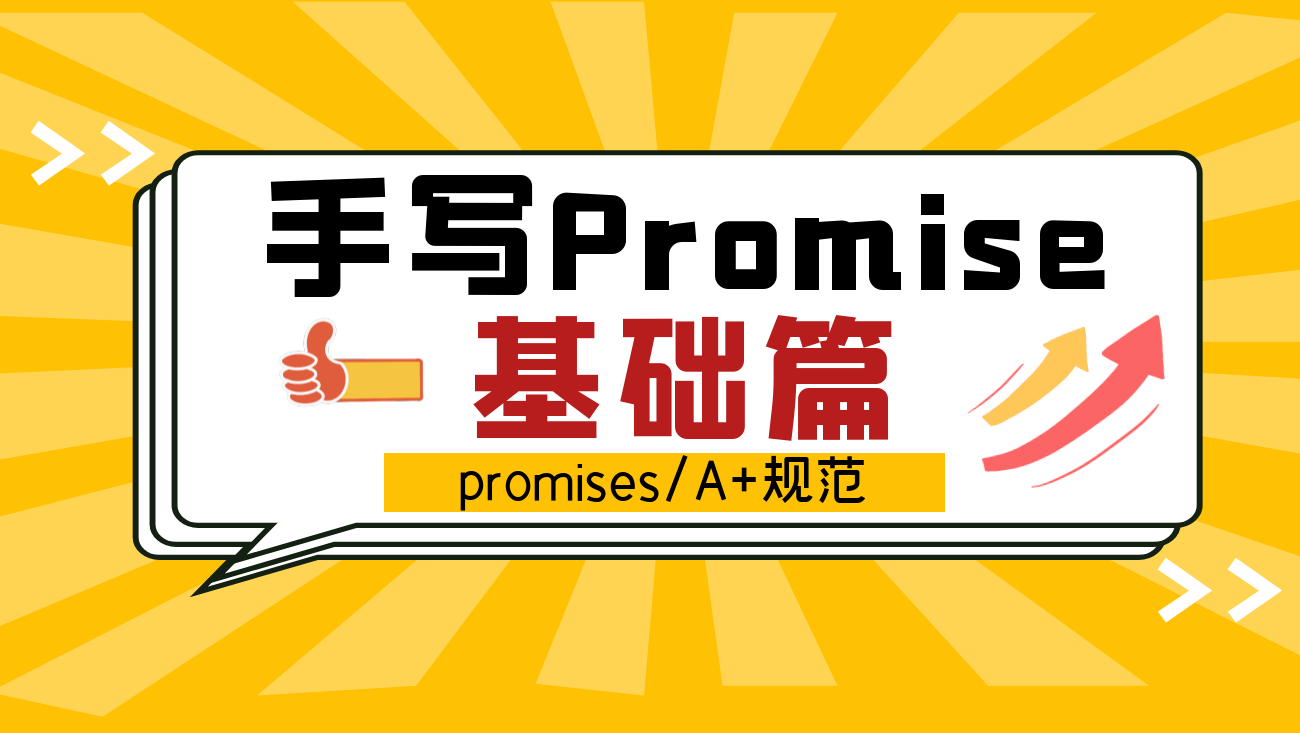
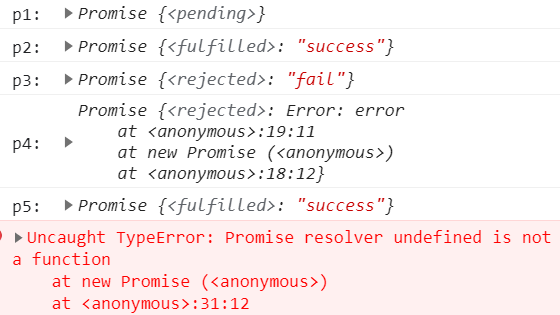
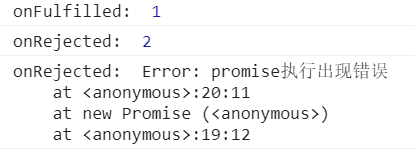

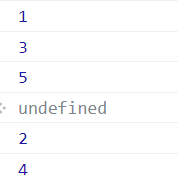

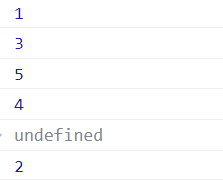

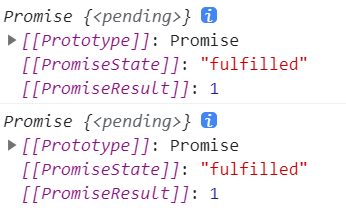













评论